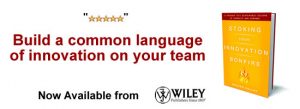Fostering an Innovative Culture
 In the last few years, innovation has become increasingly important, with the rise of outsourcing, and companies being forced to become tighter due to the global recession.
In the last few years, innovation has become increasingly important, with the rise of outsourcing, and companies being forced to become tighter due to the global recession.
People understand that they need to be innovative, they’re just not sure how or where to start.
Start at the top. If the CEO, and the other executives don’t believe in innovation, and don’t promote innovation, it will never happen. It needs to trickle down from the top.
The important thing is, to create a culture that fosters innovation within the workplace. Purina is a great example of a company that fosters innovation properly. They have created an innovation team, made up of employees from different departments across the organization, specifically dedicated to innovation. It is clear that senior management is serious about fostering innovation at Purina, and ultimately I think they will be rewarded for their efforts, through increased revenue/profit.
Google is another great example of a company that fosters innovation, with their 20% time program. The way this program works, is that 20% of a Google employees’ work week is spent on something that interests them. It gives them a chance to try new things, and explore different possibilities, and be innovative. The results have been spectacular. Gmail, Google News, Google Maps, Orkut, and Google Earth, are all pet projects of employees during their 20% time.
Upper management should be encouraging employees to start to be a little more creative on their free time. They can offer rewards, and incentivize the process, but ultimately the pride that comes with impressing your manager with a good idea is often more than enough.
I think it’s important for organizations to remove the fear factor when it comes to innovation. Let your stakeholders know that they can make mistakes without being penalized. If you knew that you could be as free, and creative as you’d like, with no repercussions, it would create a more open, and therefore innovative atmosphere.
If organizations can find a way to create an environment for employees to explore freely, the outcomes will be incredible. You will receive new, creative, good ideas. That is guaranteed.
Don’t miss an article (2,400+) – Subscribe to our RSS feed or join us on LinkedIn or Facebook.
 Jake Shriar is the VP of Marketing for BrainBank Inc. Prior to joining BrainBank, Jake was the Founder and CEO of Smart Guy Media, a social media marketing company.
Jake Shriar is the VP of Marketing for BrainBank Inc. Prior to joining BrainBank, Jake was the Founder and CEO of Smart Guy Media, a social media marketing company.
NEVER MISS ANOTHER NEWSLETTER!
LATEST BLOGS
Starbucks and Big Tobacco
Back in the 1950’s smoking was glamorous, and just about everybody who was anybody smoked cigarettes. Then came the discovery, to the shock of millions, that sucking smoke into your lungs might not be good for you. Then came another revelation that one of the substances in tobacco, nicotine, which was used as a poison by the Egyptians during the times of the Great Pyramids, is addictive. People then began a mass exodus from the consumption of nicotine via inhaled smoke.
Read MoreWal-Mart Goes Green – What about your company?
With the price of gas above $3.00, some companies (and hopefully all) are beginning to look at the fuel efficiency of their fleets. Wal-Mart is the most public example of this with its trucking fleet. Its efforts include:
Read More




There are a couple of things you may wish to consider regarding your posting:
1. People don’t have free time. Companies have cut to the bone and are making every employee perform multiple jobs at the same time. People are working hard at surviving.
2. What most business leaders would probably say is that they already innovate. Yes, they create incremental changes but they are engaged competitively in a “knife fight in a phone booth”. The question senior leaders need to define is what degree of innovation they need to grow their profit and build competitive advantage. Incremental to transformational.
3. At its core, innovation is about finding customer needs and meeting them in new ways to generate economic value. New customer value can deliver new economic value. People need to change their view from internal issues to refocusing on the customer (user,chooser, buyer, partner).
The CEO has to drive the internal shift, absolutely.
Roy,
All great points.
Thank you for your input, I think what you are saying definitely has value.